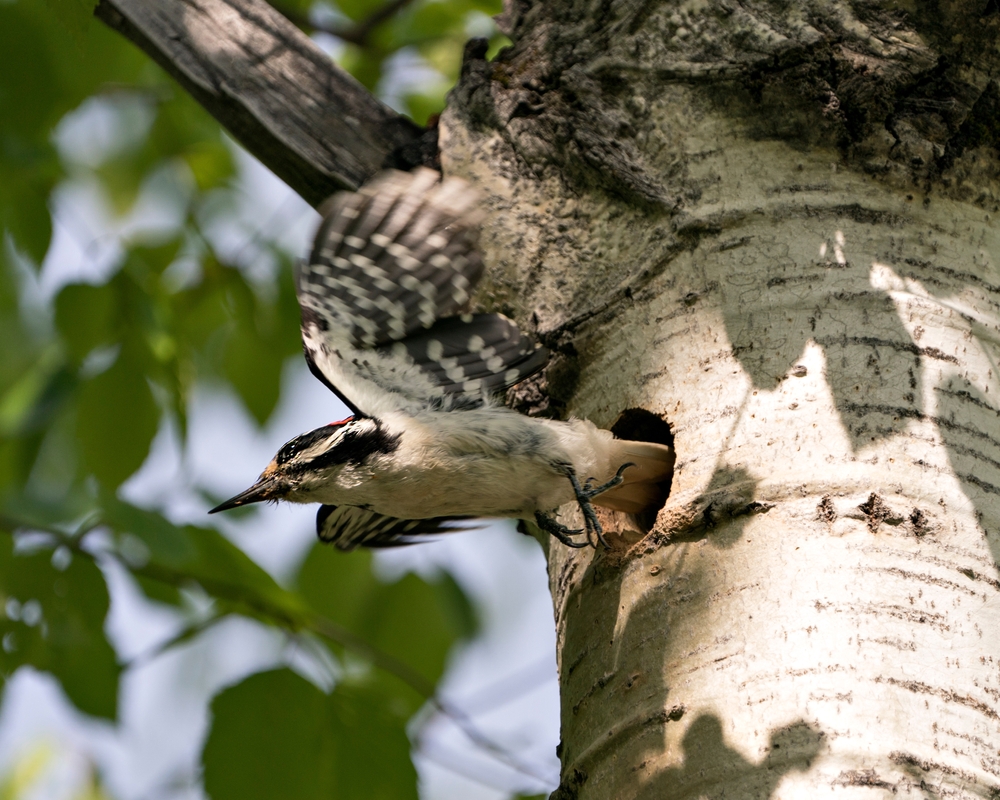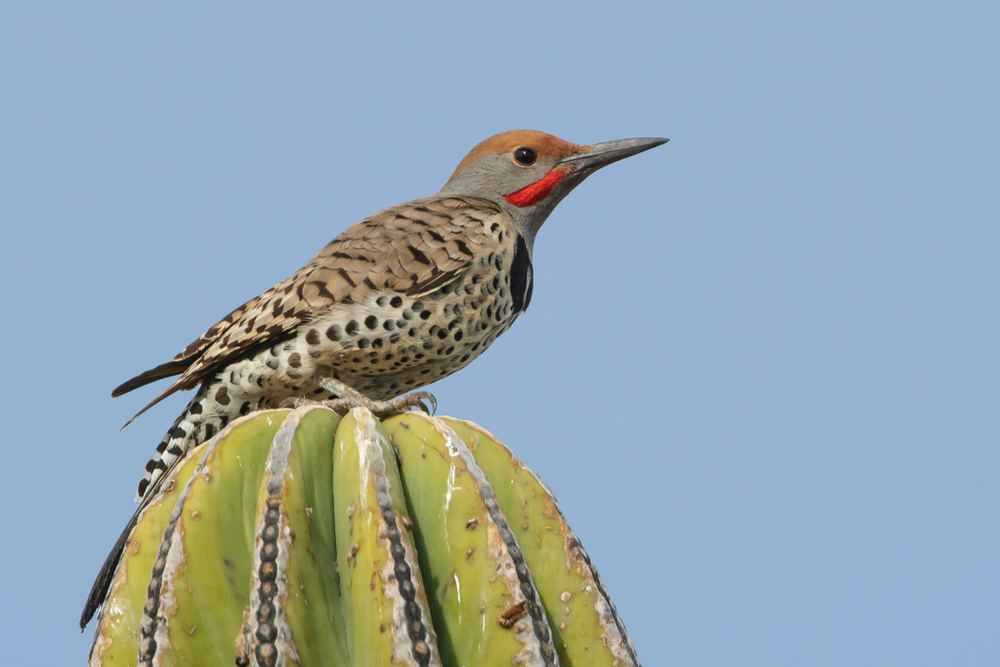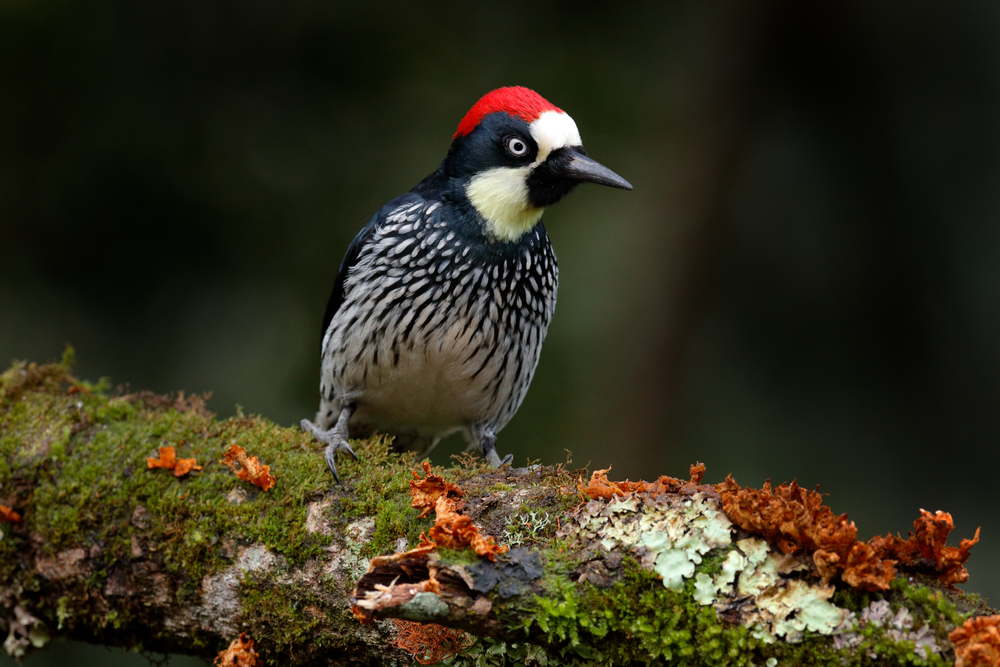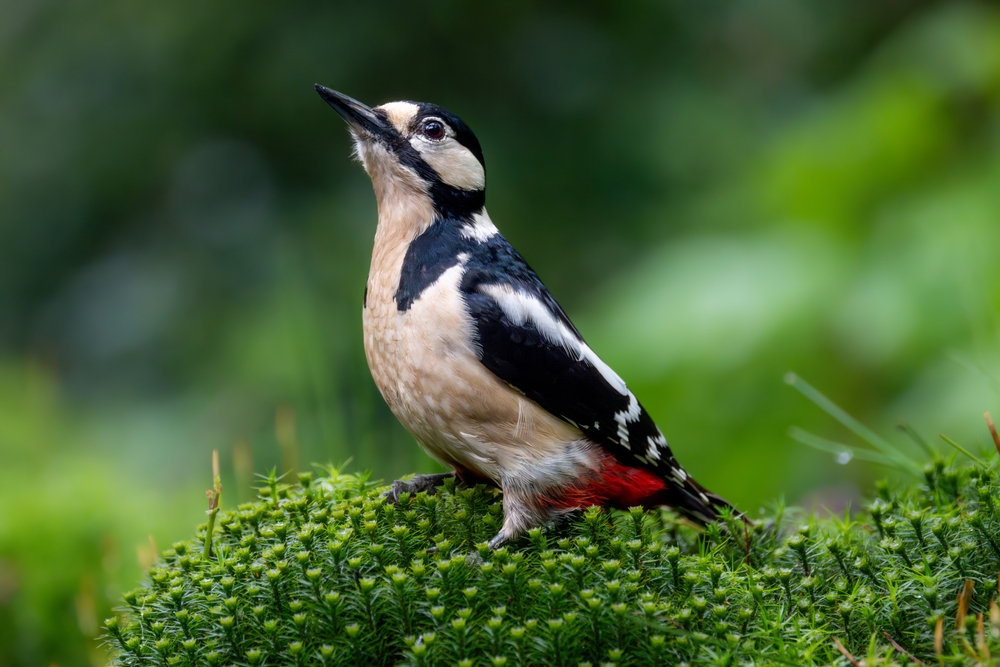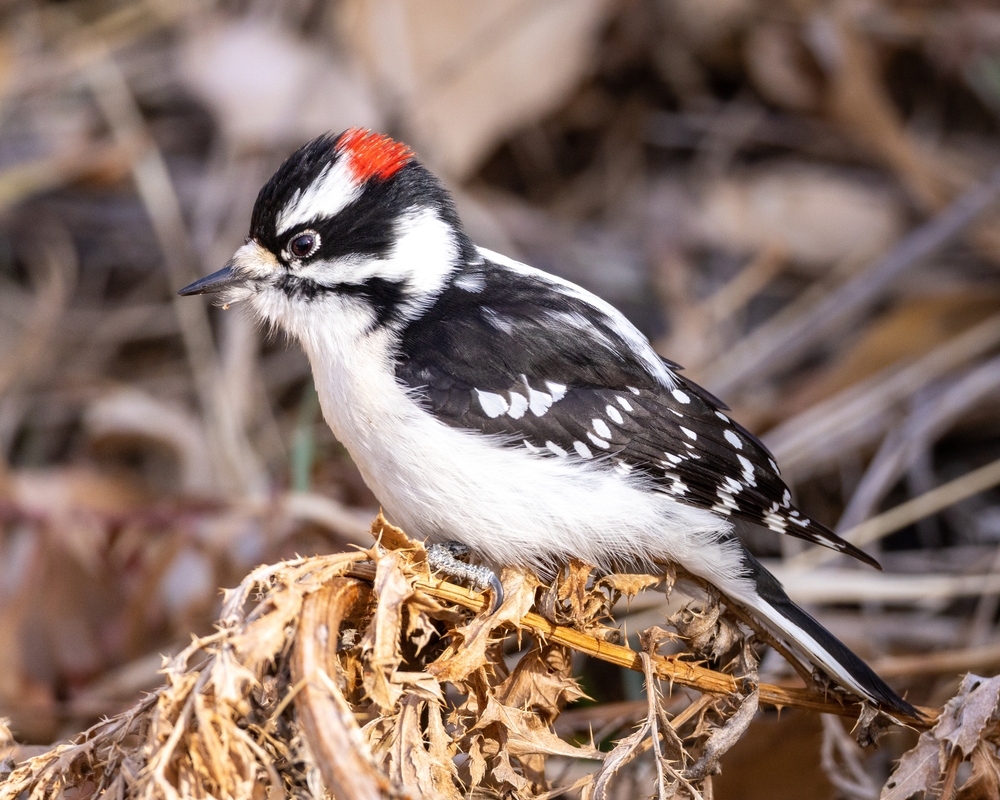The Hairy Woodpecker (Dryobates villosus) is most closely related to the Downy Woodpecker (Dryobates pubescens). Though nearly identical in appearance, the Hairy is larger with a longer, stronger beak and proportionally longer wings.
About
The Hairy Woodpecker (Dryobates villosus), part of the Picidae family, is a widespread North American woodpecker found in forests, woodlands, parks, and suburban areas. Closely resembling the Downy Woodpecker, it is larger with a proportionately longer, sturdier bill, making it an important insect predator in a wide range of habitats.
Measuring 23–26 cm (9–10 in) in length with a wingspan of 38–41 cm (15–16 in), the Hairy Woodpecker has striking black-and-white plumage. Its wings are black with white spotting, and it has a white underside and a bold white stripe running down its back. Males display a small red patch on the back of the head, absent in females. The bird’s chisel-like bill, nearly as long as its head, distinguishes it from the smaller Downy Woodpecker.
The diet of the Hairy Woodpecker consists mainly of insects, particularly wood-boring beetle larvae, ants, and caterpillars, which it excavates from tree bark and wood. It also consumes fruits, seeds, and tree sap, and will occasionally visit suet feeders in winter. By preying on insects that damage trees, it plays a valuable role in forest health.
Breeding takes place in tree cavities excavated by the pair in dead or decaying wood. The female typically lays 3–6 eggs, and both parents share incubation and feeding duties. Chicks fledge after about a month but may remain with their parents for a short period afterward. Their drumming and sharp “peek” calls are common sounds in wooded areas, especially during breeding season.
The Hairy Woodpecker is non-migratory, remaining in its range year-round, from Alaska and Canada to Central America. Adaptable to both natural and human-modified environments, its population remains stable and abundant, ensuring its continued role as a key insect controller in North American forests.
Physical Characteristics
The Hairy Woodpecker is a medium-sized North American woodpecker, often confused with the smaller Downy Woodpecker but distinguishable by its larger size and proportionally longer bill:
Head and Face:
They have a bold black-and-white facial pattern with a white stripe down the center of the head and a black line running through the eye. Males show a small red patch at the back of the head, while females lack this marking.
Beak:
The beak is long, straight, and chisel-like—about the same length as the bird’s head—well adapted for drilling into bark and extracting insects. This proportionally long bill is one of the key features separating it from the Downy Woodpecker.
Plumage:
The back is black with a long, clean white patch running down the center. Wings are black with rows of white spots, and the underparts are white. Tail feathers are black, with pure white outer feathers that lack the black spots seen on Downy Woodpeckers.
Body and Build:
They have a sturdy, elongated build with stiff tail feathers that brace against trees while climbing. Their feet are zygodactyl (two toes forward, two backward), allowing them to grip bark securely.
Size:
-
Length: 7.1 to 10.2 in (18 to 26 cm)
-
Wingspan: 13 to 16 in (33 to 41 cm)
-
Weight: 1.4 to 3.4 oz (40 to 95 g)
The Hairy Woodpecker’s clean black-and-white pattern, proportionally large bill, and strong drumming behavior make it one of the most recognizable forest woodpeckers in North America.
Reproduction
The reproductive cycle of the Hairy Woodpecker is typical of cavity-nesting woodpeckers, with both parents contributing heavily to chick rearing:
1. Courtship and Pair Formation:
Courtship occurs in late winter and early spring. Males attract females through drumming displays, calling, and offering potential nest sites. Once paired, they are monogamous for the breeding season.
2. Breeding Season:
Breeding generally occurs from April to June, varying slightly with latitude and local climate.
3. Nesting:
Pairs excavate nest cavities in dead trees, snags, or decaying branches. The cavity is usually 8 to 12 in (20 to 30 cm) deep and lined with wood chips for the eggs and chicks.
4. Egg Laying:
The female lays 3 to 6 white eggs. Both parents take turns incubating.
5. Incubation:
Incubation lasts about 11 to 12 days, with the male typically incubating at night and the female during the day.
6. Chick Development:
Chicks hatch altricial (helpless), naked, and blind. Both parents feed them insects, brought to the nest cavity and delivered directly into their beaks.
7. Fledging and Independence:
The young fledge at about 28 to 30 days of age. After leaving the nest, they remain with their parents for several weeks while learning to forage.
The Hairy Woodpecker’s strong excavation skills and cooperative parenting give it a high reproductive success rate in healthy forest habitats.
Lifespan
The Hairy Woodpecker is a moderately long-lived forest bird, with survival influenced by habitat stability and predation risks.
Lifespan in the Wild:
In their natural woodland environments, Hairy Woodpeckers typically live 4 to 7 years on average, though some individuals have been recorded living up to 15 years. High juvenile mortality in the first year lowers the average life expectancy.
Lifespan in Captivity:
With protection from predators, steady food supplies, and veterinary care, they may live longer, sometimes reaching 15+ years in managed conditions.
Threats to the Hairy Woodpecker:
-
Predation: Eggs and chicks are vulnerable to snakes, squirrels, and other cavity raiders, while adults are preyed upon by hawks and owls.
-
Habitat Loss: Logging and the removal of dead trees reduce available nesting sites.
-
Competition: Rival cavity-nesting birds, including starlings and other woodpeckers, compete for nest holes.
-
Climate Events: Harsh winters and food shortages can reduce survival rates, especially for juveniles.
Despite these threats, Hairy Woodpeckers are resilient and widely distributed across North America, maintaining stable populations where forests are preserved.
Eating Habits
The Hairy Woodpecker has a primarily insect-based diet, supplemented with plant material, making it a versatile forest forager:
Diet:
They feed mostly on insects, especially wood-boring beetle larvae, ants, caterpillars, and bark beetles. They also eat spiders, seeds, berries, nuts, and occasionally sap. In winter, they often visit bird feeders for suet and sunflower seeds.
Feeding Strategy:
Hairy Woodpeckers forage by hammering, probing, and scaling bark to uncover hidden insects. They often excavate deeper than smaller woodpeckers, such as the Downy, allowing them to exploit different food niches.
Role in Ecosystem:
By feeding heavily on wood-boring insects, they help regulate pest populations that can damage trees, making them an important ally in forest health.
Social Feeding Behavior:
They are generally solitary feeders but may forage in loose association with mixed-species flocks during winter for added protection from predators.
Feeding Technique:
Using their long, strong beak, they chisel into bark and wood, then extend their barbed, sticky tongue to capture insects hidden inside. They sometimes drum persistently in one spot until they reach their prey.
The Hairy Woodpecker’s adaptability in diet and deep foraging technique set it apart from similar species, making it a key insect controller in North American forests.
Uniqueness
The Hairy Woodpecker (Dryobates villosus) is a widespread and adaptable species, with several distinctive traits that set it apart from other woodpeckers:
Resemblance to the Downy Woodpecker:
It closely resembles the smaller Downy Woodpecker but can be distinguished by its larger size and proportionally longer beak, which is as long as its head.
Deep Foraging Ability:
Unlike smaller woodpeckers that feed on surface insects, Hairy Woodpeckers often excavate deeper into wood, allowing them to exploit hidden prey that others cannot reach.
Wide Distribution:
They are found across nearly all of North America, from Alaska and Canada through most of the United States and into parts of Mexico, making them one of the continent’s most widespread woodpeckers.
Adaptability:
Hairy Woodpeckers thrive in a variety of habitats, from dense forests to suburban parks and orchards, showing strong resilience to human-altered environments.
Role in Pest Control:
By consuming large numbers of wood-boring insects, they play an important ecological role in maintaining healthy forests and preventing tree damage.
Drumming and Calls:
Their sharp, explosive “peek” calls and rapid drumming make them one of the most easily heard woodpeckers in their range.
The Hairy Woodpecker’s deep-drilling feeding style, wide distribution, and resemblance to the Downy Woodpecker make it one of the most familiar and ecologically important woodpeckers in North America.
Be the First to Share Photos of This Species.
FAQ’s
1. What species is closest to the Hairy Woodpecker?
2. How does the Hairy Woodpecker compare to other woodpeckers?
It is larger and more powerful than the Downy Woodpecker, with the ability to excavate deeper into wood to reach hidden insects. While not as large as the Pileated Woodpecker, it is widespread and adaptable, thriving in both wild forests and suburban habitats.
3. What national parks provide the best opportunity to see a Hairy Woodpecker?
Hairy Woodpeckers are found across North America. Some of the best national parks to spot them include:
-
Yellowstone National Park, USA
-
Rocky Mountain National Park, USA
-
Yosemite National Park, USA
-
Acadia National Park, USA
-
Banff National Park, Canada
These forested parks provide prime habitat for observing Hairy Woodpeckers as they drum, forage for insects, and excavate nest cavities.



































































